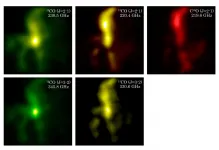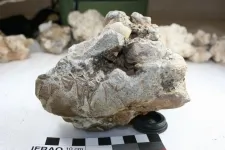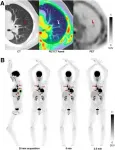New radio receiver opens wider window to radio universe
2021-07-08
(Press-News.org) Researchers have used the latest wireless technology to develop a new radio receiver for astronomy. The receiver is capable of capturing radio waves at frequencies over a range several times wider than conventional ones, and can detect radio waves emitted by many types of molecules in space at once. This is expected to enable significant progresses in the study of the evolution of the Universe and the mechanisms of star and planet formation.
Interstellar molecular clouds of gas and dust provide the material for stars and planets. Each type of molecule emits radio waves at characteristic frequencies and astronomers have detected emissions from various molecules over a wide range of frequencies. By observing these radio waves, we can learn about the physical properties and chemical composition of interstellar molecular clouds. This has been the motivation driving the development of a wideband receiving system.
In general, the range of radio frequencies that can be observed simultaneously by a radio telescope is very limited. This is due to the characteristics of the components that make up a radio receiver. In this new research, the team of researchers in Osaka Prefecture University (OPU) and the National Astronomical Observatory of Japan (NAOJ) has widened the bandwidth of various components, such as the horn that brings radio waves into the receiver, the waveguide (metal tube) circuit that propagates the radio waves, and the radio frequency converter. By combining these components into a receiver system, the team has achieved a range of simultaneously detectable frequencies several times larger than before. Furthermore, this receiver system was mounted on the OPU 1.85-m radio telescope in NAOJ's Nobeyama Radio Observatory, and succeeded in capturing radio waves from actual celestial objects. This shows that the results of this research are extremely useful in actual astronomical observations.
"It was a very emotional moment for me to share the joy of receiving radio waves from the Orion Nebula for the first time with the members of the team, using the receiver we had built," comments Yasumasa Yamasaki, an OPU graduate student and the lead author of the paper describing the development of the wideband receiver components. "I feel that this achievement was made possible by the cooperation of many people involved in the project."
When compared to the receivers currently used in the Atacama Large Millimeter/submillimeter Array (ALMA), the breadth of frequencies that can be simultaneously observed with the new receivers is striking. To cover the radio frequencies between 211 and 373 GHz, ALMA uses two receivers, Band 6 and 7, but can use only one of them at a given time. In addition, ALMA receivers can observe two strips of frequency ranges with widths of 5.5 and 4 GHz using the Band 6 and 7 receivers, respectively. In contrast, the new wideband receiver can cover all the frequencies with a single unit. In addition, especially in the higher frequency band, the receiver can detect radio waves in a frequency range of 17 GHz at a time.
"It was a very valuable experience for me to be involved in the development of this broadband receiver from the beginning to successful observation," says Sho Masui, a graduate student at OPU and the lead author of the research paper reporting the development of the receiver and the test observations. "Based on these experiences, I would like to continue to devote further efforts to the advancement of astronomy through instrument development."
This wideband technology has made it possible to observe the interstellar molecular clouds along the Milky Way more efficiently using the 1.85-m radio telescope. In addition, widening the receiver bandwidth is listed as one of the high priority items in the ALMA Development Roadmap which aims to further improve the performance of ALMA. This achievement is expected to be applied to ALMA and other large radio telescopes, and to make a significant contribution to enhance our understanding of the evolution of the Universe.
INFORMATION:
These research results are presented in the following two papers published in the Publications of the Astronomical Society of Japan.
S. Masui et al. "Development of a new wideband heterodyne receiver system for the Osaka 1.85 m mm-submm telescope: Receiver development and the first light of simultaneous observations in 230 GHz and 345 GHz bands with an SIS-mixer with 4-21?GHz IF output" https://doi.org/10.1093/pasj/psab046
Y. Yamasaki et al. "Development of a new wideband heterodyne receiver system for the Osaka 1.85?m mm-submm telescope: Corrugated horn and optics covering the 210-375?GHz band" https://doi.org/10.1093/pasj/psab062
[Attachments] See images for this press release:

ELSE PRESS RELEASES FROM THIS DATE:
2021-07-08
(Boston)--As analytical instrumentation (gas- and liquid-chromatographs coupled with mass spectrometers) increase in sensitivity and speed, forensic scientists may find themselves still hindered by the process of preparing samples (blood, urine, etc.) for analysis and seeking more efficient approaches.
In an article in WIRES Forensic Science, researchers from Boston University School of Medicine's (BUSM) Biomedical Forensic Sciences program, provide an overview of sample preparation techniques and information on routine sample types that may be encountered in forensic toxicology cases.
Forensic toxicology encompasses a large variety of scenarios including drug-facilitated crimes, understanding ...
2021-07-08
A new UBC Sauder School of Business study shows that depending on how employees understand their boss' motivation, employees can feel anger or guilt, and consequently, react differently to abusive supervision.
Former Apple CEO Steve Jobs was a famously harsh corporate leader, one who pushed his employees to extremes to achieve the company's lofty aims.
But while many aspiring leaders still believe that the "tough love" approach is effective, a new study from UBC Sauder shows that, even when abusive leadership is meant to push employees to new heights, it can land them in deep lows in the long term.
Abusive supervision -- which includes behaviours like yelling at employees, giving them the silent treatment, or putting them down in front of their ...
2021-07-08
More than a third of coal miners and former coal miners suffering from black lung disease struggle with depression, and more than one in 10 has recently considered suicide, a new study finds.
The study is believed to be the first to examine mental-health issues in a large population of coal miners in the United States. Based on the troubling results, the researchers are calling for more mental health resources and treatment for current and former miners. They also are urging further study of potential contributors to the problem, including social determinants of health, ...
2021-07-08
Evidence from an ancient eggshell has revealed important new information about the extreme climate change faced by human early ancestors.
The research shows parts of the interior of South Africa that today are dry and sparsely populated, were once wetland and grassland 250,000 to 350,000 years ago, at a key time in human evolution.
Philip Kiberd and Dr Alex Pryor, from the University of Exeter, studied isotopes and the amino acid from ostrich eggshell fragments excavated at the early middle Stone Age site of Bundu Farm, in the upper Karoo region ...
2021-07-08
Reston, VA--A performance evaluation of the uEXPLORER total-body PET/CT scanner showed that it exhibits ultra-high sensitivity that supports excellent spatial resolution and image quality. Given the long axial field of view (AFOV) of the uEXPLORER, study authors have proposed new, extended measurements for phantoms to characterize total-body PET imaging more appropriately. This research was published in the June issue of The Journal of Nuclear Medicine.
uEXPLORER is the world's first commercially available total-body PET scanner. The scanner has an AFOV of 194 cm, which allows PET data collection from the ...
2021-07-08
Scientists at the Department of Energy's Oak Ridge National Laboratory and the University of Tennessee, Knoxville, have found a way to simultaneously increase the strength and ductility of an alloy by introducing tiny precipitates into its matrix and tuning their size and spacing. The precipitates are solids that separate from the metal mixture as the alloy cools. The results, published in the journal Nature, will open new avenues for advancing structural materials.
Ductility is a measure of a material's ability to undergo permanent deformation without breaking. It determines, among other ...
2021-07-08
Batteries are potentially a game-changing technology as we decarbonize our economy, and their benefits are even greater when shared across communities, a University of Otago-led study has found.
Co-author Associate Professor Michael Jack, Director of the Energy Programme in the Department of Physics, says reducing costs are seeing rapid deployment of batteries for household use, mainly for storing solar and wind power for later use, but they could have a variety of uses in a future electricity grid.
"For example, they could be used to feed energy back into the grid when there is a shortfall in renewable supply. ...
2021-07-08
Firearm purchases and firearm violence surged dramatically during the first five months of the COVID-19 pandemic, according to a new study from the UC Davis Violence Prevention Research Program (VPRP), published in Injury Epidemiology.
From March through July 2020, an estimated 4.3 million more background checks for firearm purchases occurred nationwide than would have ordinarily -- an 85 percent increase. The total number of firearm purchases during this period was 9.3 million.
From April through July 2020, there was a 27% increase in interpersonal firearm injuries, which includes firearm homicides or nonfatal firearm assault injuries. This is approximately 4,075 more injuries ...
2021-07-08
Eight pieces of salmon-based maki, nigiri or sashimi or maki unagi (eel) is the safest combination of sushi for adult and adolescent populations. That is one of the findings of TecnATox (Centre for Environmental, Food and Toxicological Technology), a joint research group from the URV and the Pere Virgili Health Research Institute (IISPV), which has analysed the presence of arsenic and various heavy metals in sushi. The consumption of sushi has increased significantly since the start of the 21st century, as has the number of restaurants offering it throughout the region. Although eating fish is recommended because of its high nutritional value, it can also lead to exposure to contaminants, such as heavy metals. Likewise, rice is a food that provides many nutrients ...
2021-07-08
The rationale for the research is in the fact that despite the high number of recognized Indigenous groups who are struggling to maintain their languages, cultures, and identities in Russia, there is little research done on the matters of cultural and linguistic revitalization. This study sought to address this gap by exploring the views of two Indigenous groups, Karelian and Mari, on the development of their Indigenous languages and educational strategies to protect and revive their languages. The study relied on in-depth one-on-one interviews with 20 participants, ten from each Indigenous group.
The findings show that despite older generations' relative proficiency and interest in their respective Indigenous languages, motivation to master them is ...
LAST 30 PRESS RELEASES:
[Press-News.org] New radio receiver opens wider window to radio universe





